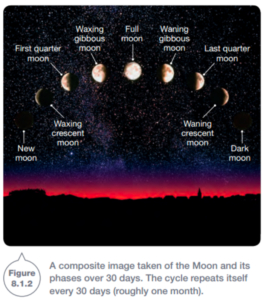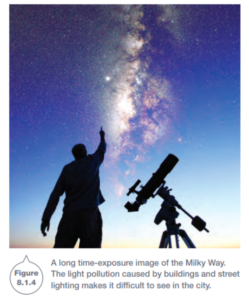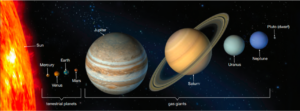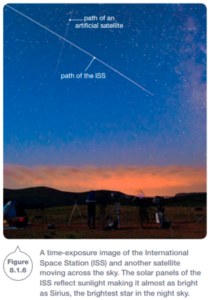Look into a clear night sky and you will see ·· stars, cloudy blurs of light made up of even more stars, and most probably part of the Moon. A few of those starry points of light aren’t stars at all but are planets. A couple of ‘stars’ might even shoot across the sky. They aren’t stars either, but meteors. The night sky is Earth’s view of the rest of the universe, its stars, constellations, planets, dwarf planets, moons, meteoroids, asteroids and comets.
Observing the night sky
A telescope is a tool used by astronomers to watch the night sky. The telescope allows them to see particular characteristics that are not visible to the naked eye. This is because the lights in the sky that we call ‘stars’ are sometimes the light of stars, a handful is planets, a few might be meteoroids or comets.
The moon is the biggest and brightest object in the night sky. The moon doesn’t make its own light bt acts like a giant mirror in the sky, reflecting the sunlight down to you.
Sometimes you will see the Moon’s full face (known as a full Moon) with its craters and ‘seas’. At other times, you will only see half of it (a quarter Moon) or a slice of it (a crescent Moon). These different views of the Moon are known as its **phases.**These are shown in Figure 8.1.2.
The Sun lights up half of the Moon but we on Earth don’t always see that half: what phase you see depends on how the Moon, Sun, and Earth are arranged in space.

Stars are massive burning balls of hydrogen gas. Hydrogen is explosive but the light and heat that comes from stars are not from ‘normal’ hydrogen explosions. It comes from nuclear explosions instead! A nuclear reaction (called a fusion reaction) converts hydrogen into helium, releasing enormous amounts of energy as heat, light, and radioactivity as it does so.
The milky way
A band of light runs across the night sky from one horizon to the other. This is the milky way. What we are seeing are the stars in the same galaxy as us.

Planets
There are 2 types of planets
- Rocky (terrestrial) pla nets- these planets are like earth and are made of rocky material
- Gas giants- gas giants are made of huge amounts of gases.
Terrestrial Planets of our solar system:
- Murcury
- Venus
- Earth
- Mars
Gas giants of our solar system
- Jupiter
- Saturn
- Uranus
- Neptune

Other things you might see
Aritificial satelites
These are man-made objects you see orbiting the earth in the night sky.

Shooting stars
These are space debris and rocks burning up in our atmosphere.
Types of shooting stars
- Metroid- Small rock or particle from 1mm-10m across
- Meteor the rock falling through the earth’s atmosphere as a blazing fireball (15 Km/second)
- Meteorite- what hits the earth
- Asteroids- large meteors

